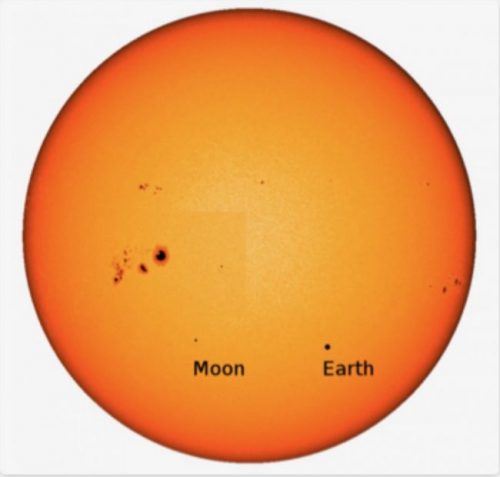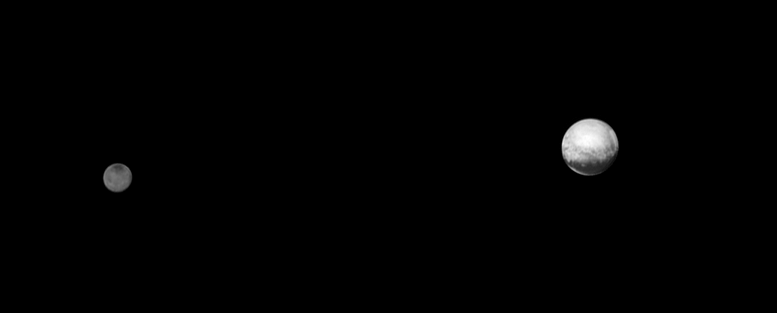
This article is by Anne Verbiscer, a research professor in the Department of Astronomy at the University of Virginia and an Assistant Project Scientist for the New Horizons Kuiper Belt Extended Mission. She told EarthSky in early July 2018 that, during the upcoming Pluto alignment, astronomers will be using using the Hubble Space Telescope and ground-based facilities including Magellan and SOAR in Chile, and Mount Palomar in California. The article was originally published by NASA’s Pluto New Horizons website. Reprinted here with permission.
Every year, planets orbiting the sun beyond Earth’s orbit reach what astronomers call opposition, when they appear in the sky at the position opposite that of the sun. At opposition, the planet, satellite or asteroid and the sun line up with Earth between them. Pluto and its moons will be at opposition in 2018 on July 12 at 09:42 UTC; translate UTC to your time. Sometimes these alignments are so precise that if you were standing on the surface of one of these bodies and looking back at Earth, you would see our planet transit (or move across) the solar disk.
These “special” oppositions take place when the planet is near what is called the line of nodes. The line of nodes is the intersection of the plane of the Earth’s orbit and a planet’s orbit. Look back at the image above. The line of nodes is the intersection between the orbital plane of Pluto (purple) and that of Earth (white). Because Pluto’s orbit is significantly inclined relative to the ecliptic plane, node crossings are rare, and because Pluto’s orbit is eccentric, they occur in 87- and 161-year intervals.
If the planet is near one of these intersection points at the time of its yearly opposition, it is in near-perfect alignment with the Earth and sun. Such is the case in 2018.
Pluto was last near one of these intersection points in 1931. On July 12, 2018, as seen from Pluto, Earth will cross the sun’s face. It will not be a central transit, but it will be a transit nonetheless.
After that, because of the eccentricity of Pluto’s orbit, it will be another 161 years until the next perfect alignment opportunity.
Read more about the Earth transit seen from Pluto on July 12

Pluto’s last node crossing was within one year of Clyde Tombaugh’s discovery in 1930. Did Tombaugh discover Pluto because it happened to lie right in the plane of the Earth’s orbit and the orbits of most of the other planets in the solar system in 1930? Probably.
But did the fact that objects tend to be brighter, sometimes exceptionally so when they are near opposition, also increase Tombaugh’s chances of making his famous discovery? Perhaps. Pluto was definitely brighter at that time, but just how much brighter? And why was it brighter? To answer those questions, we need to investigate the opposition effect.
The Opposition Effect
The surfaces of airless bodies in the solar system all exhibit an opposition effect. This is the (sometimes dramatic) increase in reflected sunlight that occurs when a planet, moon, asteroid or comet is at opposition. The angle between the sun and Earth as seen from the planet is called the solar phase angle, or simply the phase angle. The opposition effect is the increase in brightness observed as the phase angle decreases to zero.
Saturn and its rings and moons had their node crossing in January 2005, and several of the world’s telescopes were watching. The 2.2-meter telescope at Calar Alto Observatory in Spain obtained the three images below at different phase angles. When Saturn was at opposition on the night of January 13, 2005, the phase angle decreased to 0.02 degrees and the rings became stunningly bright, far brighter than they were at a larger phase angle in February and even brighter than they were just one night after opposition. Why did the rings get so bright? And why did Saturn not get bright?

The opposition effect is the product of two phenomena: particle shadow hiding and coherent backscatter. When a planetary surface or ring is at opposition, particles can hide their own shadows and contribute to an increase in brightness. Additionally, incident (or incoming) rays of sunlight can interfere constructively with sunlight reflected from the surface at opposition and increase the observed brightness. Atmospheres, however, do not exhibit dramatic opposition effects like the rings and moons do. Astronomers watching Saturn’s moons on the night of January 13 were amazed to see Rhea, Saturn’s second largest moon, appear brighter than mighty Titan, Saturn’s largest moon, which is covered by a thick atmosphere. Despite the fact that Rhea’s projected surface area is more than 11 times smaller than Titan’s, it was visibly brighter entirely due to the opposition effect.
The Opposition Effect and Analyzing New Horizons Data
So what does the opposition effect tell us about a planetary surface? By carefully measuring the change in reflectance as phase angles get smaller and smaller, physical surface properties such as porosity, particle size and transparency can be discerned from the opposition effect.
The quantitative analysis of how light is scattered from a particulate surface requires looking at all viewing angles, not just at opposition or at “full moon,” but all the way to “thin crescent.” As New Horizons approached Pluto last year, the phase angle was about 15 degrees, and through the encounter, the phase angles at which New Horizons instruments viewed Pluto and its moons grew larger and larger until they were finally viewing these bodies backlit by the sun at phase angles near 170 degrees.
But New Horizons never viewed Pluto or its moons at phase angles smaller than eight percent, far larger than the phase angles attainable from Earth and at opposition. Because of the size of Earth’s orbit viewed from Pluto, Pluto and its moons can never be observed from Earth at phase angles larger than about two degrees.
By combining the data gathered by New Horizons at larger phase angles with data acquired from Earth-based telescopes, we can measure some physical properties of the surfaces in the Pluto system by studying the manner in which sunlight is scattered from them. Observations at larger phase angles tell us about surface roughness, while those at the smallest phase angles hold clues to the particle sizes and how tightly they are compacted, or the surface porosity.

What will happen when Pluto and its moons cross their line of nodes on July 12, 2018? Charon is normally about half as bright as Pluto, but when at opposition near the line of nodes, will it appear brighter than Pluto, like Rhea was brighter than Titan when Saturn crossed its line of nodes in 2005? Probably not, since Pluto’s atmosphere is much thinner than Titan’s. How much of a boost in reflectance did Pluto’s opposition effect give Clyde Tombaugh? We won’t know just how bright Pluto can get until 2018, but you can be sure we will be watching to find out, and to learn more about the fascinating surfaces of Pluto and Charon!

Bottom line: Pluto will be in near-perfect alignment with the Earth and sun in July 2018. On July 12, 2018, Earth will transit the sun as seen from Pluto. Astronomers are ready!
Read more about the Earth transit seen from Pluto on July 12
See photos of the May 9, 2016, transit of Mercury seen from Earth
See photos of the June 5-6, 2012, transit of Venus seen from Earth











